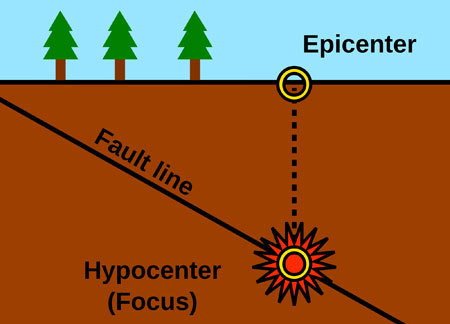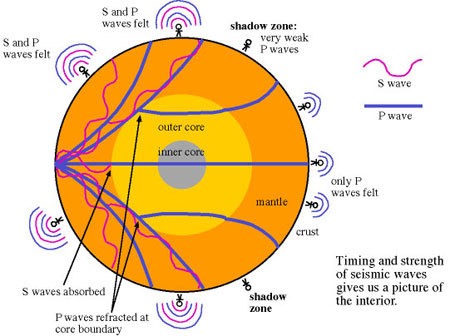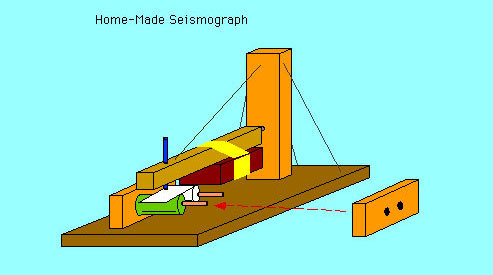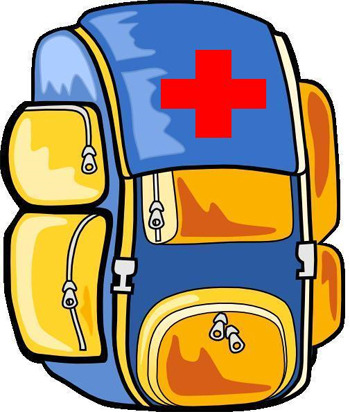Thousands of earthquakes happen across the US each year. The good thing is, almost all of them are too small to feel. Most earthquakes in North America happen west of the Rocky Mountains, but there are still 39 states that are at serious risk for quakes.
Plate Tectonics
Our planet is divided into a three main layers: a solid core, a liquid magma mantle and a crust , which floats on top. That top crust is made up of individual plates, which are kept in constant motion by convection currents in the magma.
 Tectonic Plates
Tectonic Plates
Types of Plate Boundaries
Earthquakes mostly occur at the boundary where one plates meets another. Plates either converge, collide, diverge or move past each other when they meet. When plates "converge," it means that one plate is slowly pushed beneath the other over the span of several thousand years. Plates that collide push rock layers upward, which creates mountains. When plates move away from each other or "diverge," lava comes up from the mantle and cools to form new sections of crust. Other plates simply move slowly past each other.
 Before and after shot of earthquakeCourtesy of eSchooltoday
Before and after shot of earthquakeCourtesy of eSchooltoday
Earthquake!
In some places, the plates become locked together. Energy builds up in the locked plates, which is released in the form of an earthquake when the plates finally give. The place where the earthquake originates beneath the surface is called the hypocenter. The point on the surface directly above the hypocenter is called the epicenter - a word you've probably heard many times in the news whenever a major earthquake is reported.

Ride the Waves
An earthquake emits its power as three waves of energy. Primary waves (a.k.a. P-Waves) are felts as a sudden jolt. Secondary waves (a.k.a. S-waves) arrive moments later and are felt as a more ongoing side-to-side shaking. Surface waves arrive after the main P and S waves, and radiate outwards from the epicenter.
 Earthquake Waves
Earthquake Waves
Recording Zigzags
A seismograph is a machine that records the ground vibrations during a quake. A needle keeps drawing straight lines until the earth trembles, then the lines start to zigzag. The bigger the zigzags, the bigger the quake. The strength of an earthquake is measured by the Richter scale. Based on the seismograph readings, the Richter scale rates a quake using numbers 0-9, nine being the mother of all quakes.
 Home-Made Seismograph
Home-Made Seismograph
Earthquakes: The Richter Scale
- Generally not felt, except by instruments.
- Generally not felt, except by instruments.
- Sometimes felt by people, but no damage.
- Sometimes felt by people, but no damage.
- Felt by most people, damage near epicenter (where the plates actually smashed into one another).
- Damage to buildings within six miles (10 km) of the epicenter.
- Serious damage to buildings within 60 miles (100 km) of the epicenter. Loss of life.
- Major earthquake with damage being caused to a huge area. Loss of life over 120 miles (200 km).
- Very rare. Major damage and loss of life up to 600 miles (1,000 km) away.
 The Richter Scale
The Richter Scale
Are They Predictable?
So far, scientists have yet to develop a reliable way of predicting earthquakes. There are, of course, many factors that they believe lead up to earthquakes, like change in groundwater chemistry, foreshocks (small, insignificant quakes) and strain in underground rocks. Because each quake seems to be caused by a different combination of these factors, it makes it very difficult to make predictions far enough in advance to help people. Seconds before a quake, pets like dogs and cats might get a little freaky, as they seem to be able to feel the trembling well before we do.!

What To Do In An Earthquake
One of the biggest quake dangers is being hit on the head or trapped under something. If you are indoors, stay put. Place something protective on your head and crouch under a table or stand in a doorway. If you are outside, quickly find an open space and stay away from things that will fall on you. After an earthquake, be prepared for aftershocks. Aftershocks follow earthquakes and are usually smaller than the actual quake. They are dangerous because they can cause things that were weakened from the original earthquake to fall down.
 Earthquake Preparedness Kit
Earthquake Preparedness Kit
For more information on earthquakes check out check out www.fema.com.
Related Stories

































